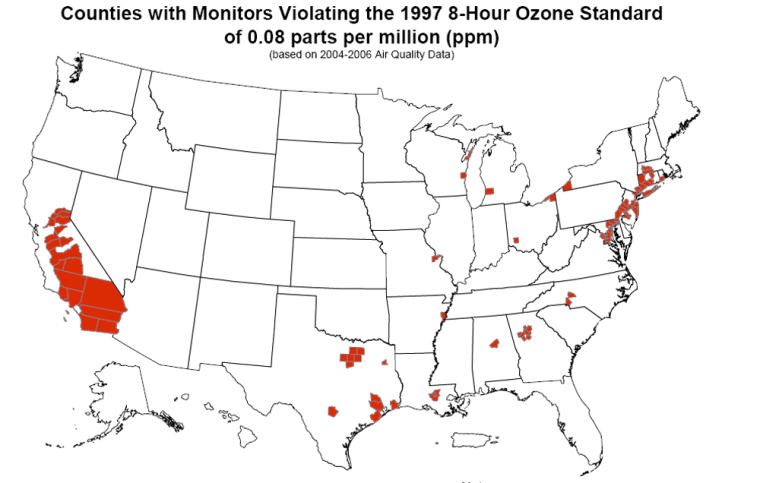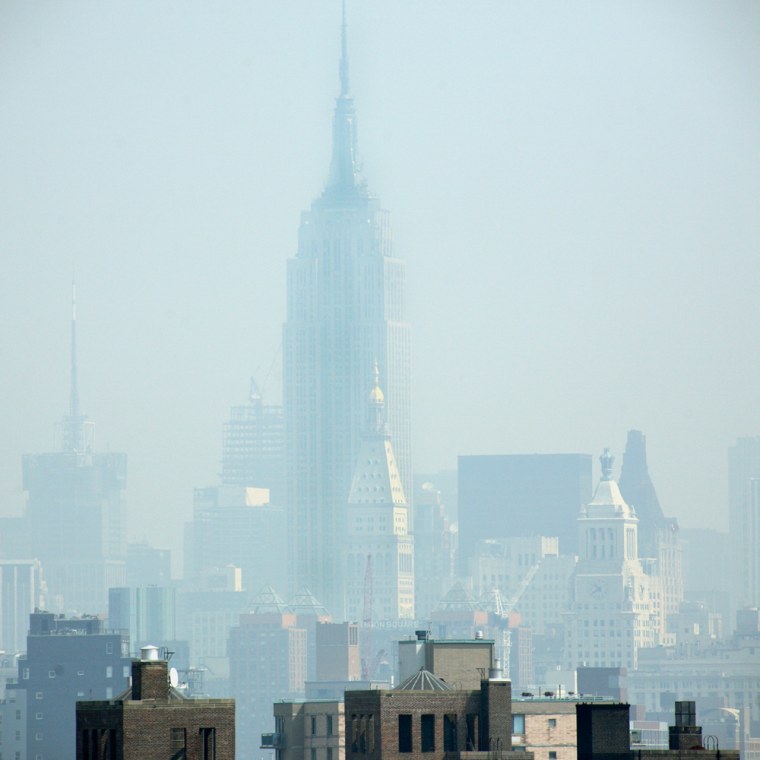The air in hundreds of U.S. counties is simply too dirty to breathe, the government said Wednesday, ordering a multibillion-dollar expansion of efforts to clean up smog in cities and towns nationwide.
The Environmental Protection Agency announced it was tightening the amount of ozone, a key component of smog, that will be allowed in the air. But the lower standard still falls short of what most health experts say is needed to significantly reduce heart and asthma attacks from breathing smog-clogged air.
EPA Administrator Stephen Johnson called the new limits "the most stringent standards ever," and he said they will require 345 counties — out of more than 700 that are monitored — to make air quality improvements because they now have dirtier air than is healthy to breathe.
Johnson said that state and local officials have considerable time to meet the requirements — as much as 20 years for some that have the most serious pollution problems. The EPA estimates that by 2020 the number of counties failing to meet the new health standard will drop to about 28.
About 85 counties still fall short of the old standard enacted a decade ago.
Large areas would fail
Some of those chronic polluters are far above the old limit — Los Angeles County and a large swatch of southern California, for example, and a long stretch from Washington up to New England on the East Coast. Some areas that would be newly included under the stricter standard include Indianapolis and Cleveland's Cuyahoga County in the Midwest; Mobile, Ala., and Jacksonville, Fla., in the South and El Paso, Texas, and Tulsa, Okla., out West.
All of Florida and Oklahoma currently comply with the smog standard. Nine counties in each state don't meet the tougher requirement.
Johnson's decision was met with sharp criticism from health experts and some members of Congress accused the EPA chief of ignoring the science. The new standard goes counter to the recommendations of two of the agency's scientific advisory panels — one on air quality and the other on protection of children.
The new EPA standard will lower the allowable concentration of ozone in the air to no more than 75 parts per billion, compared with the old standard of 80.
New limits assailed
The science boards had told the agency that limits of 60 to 70 parts per billion are needed to protect the nation's most vulnerable citizens, especially children, the elderly and people suffering from asthma and other respiratory illnesses.
"Today's decision means millions of Americans will not get the protection that the law requires," said Bernadette Toomey, president of the American Lung Association, which had strongly urged the EPA to follow the advice of the science boards.
Johnson said he took those recommendations into account, but disagreed with the scientists. "In the end it is a judgment. I followed my obligation. I followed the law. I adhered to the science," Johnson said in a conference call with reporters.
Johnson said he did not consider the cost of meeting the new air standard. States and counties would have to require emission reductions from factories, power plants and cars to meet the tougher health rules.
‘Benefits likely greater than cost’
The EPA estimated that compliance with a smog standard of 75 parts per billion would cost $7.6 billion to $8.5 billion a year and "yield health benefits valued between $2 billion and $19 billion."

"Benefits are likely greater than the cost of implementing the standards," said the EPA in a statement.
Electric utilities, oil companies and other businesses had lobbied hard for leaving the smog rule alone, saying the high cost of lower limits could hurt the economy.
The federal Clean Air Act requires that health standards for ozone and a handful of other air pollutants not take costs into account.
But Johnson said that ought to change. He said the Bush administration plans to propose legislation to Congress to overhaul the 1970 law so that in the future costs can be considered when setting health standards.
Any such move is likely to be met with strong opposition in Congress. Health experts and environmentalists view the setting of health standards without consideration of cost as essential for assuring public health.
Such changes "would gut the Clean Air Act which has saved countless lives and protected the health of millions of Americans for more than 35 years," said Sen. Barbara Boxer, D-Calif., chairman of the Senate Environment and Public Works Committee.
"It's disheartening that once again EPA has missed a critical opportunity to protect public health and welfare by ignoring the unanimous recommendations of its independent science advisers," said William Becker, executive director of the National Association of Clean Air Agencies, whose members will be developing programs to meet the federal air quality requirement.
Becker acknowledged that the tighter the standard the more difficult it will be to meet, but he said: "The public deserves the right to know whether the air they breathe is healthy."
Industry worries about economic harm
In recent weeks, some of the most powerful industry groups in Washington have waged an intense lobbying campaign at the White House, urging the administration to keep the current standard.
Electric utilities, the oil and chemical industries and manufacturing groups argued that lowering the standard would require states and local officials to impose new pollution controls, harming economic growth, when the science has yet to determine the health benefits conclusively. The 80 parts per billion standard was enacted by the EPA in 1997, but its implementation was delayed for several years because of court challenges by industry groups.
"Hundreds of counties haven't been able to meet the current standard set a decade ago," said John Kinsman, senior director for environment at the Edison Electric Institute, which represents most of the country's power companies. "Moving the goalpost again will inflict economic hardship on those areas without speeding air quality improvements."
The EPA has said, based on various studies, cutting smog from 80 to 75 parts per billion would prevent between 900 and 1,100 premature deaths a year and mean 1,400 fewer nonfatal heart attacks and 5,600 fewer hospital or emergency room visits. A separate study suggests that tightening the standard to 70 parts per billion could avoid as many as 3,800 premature deaths nationwide.
